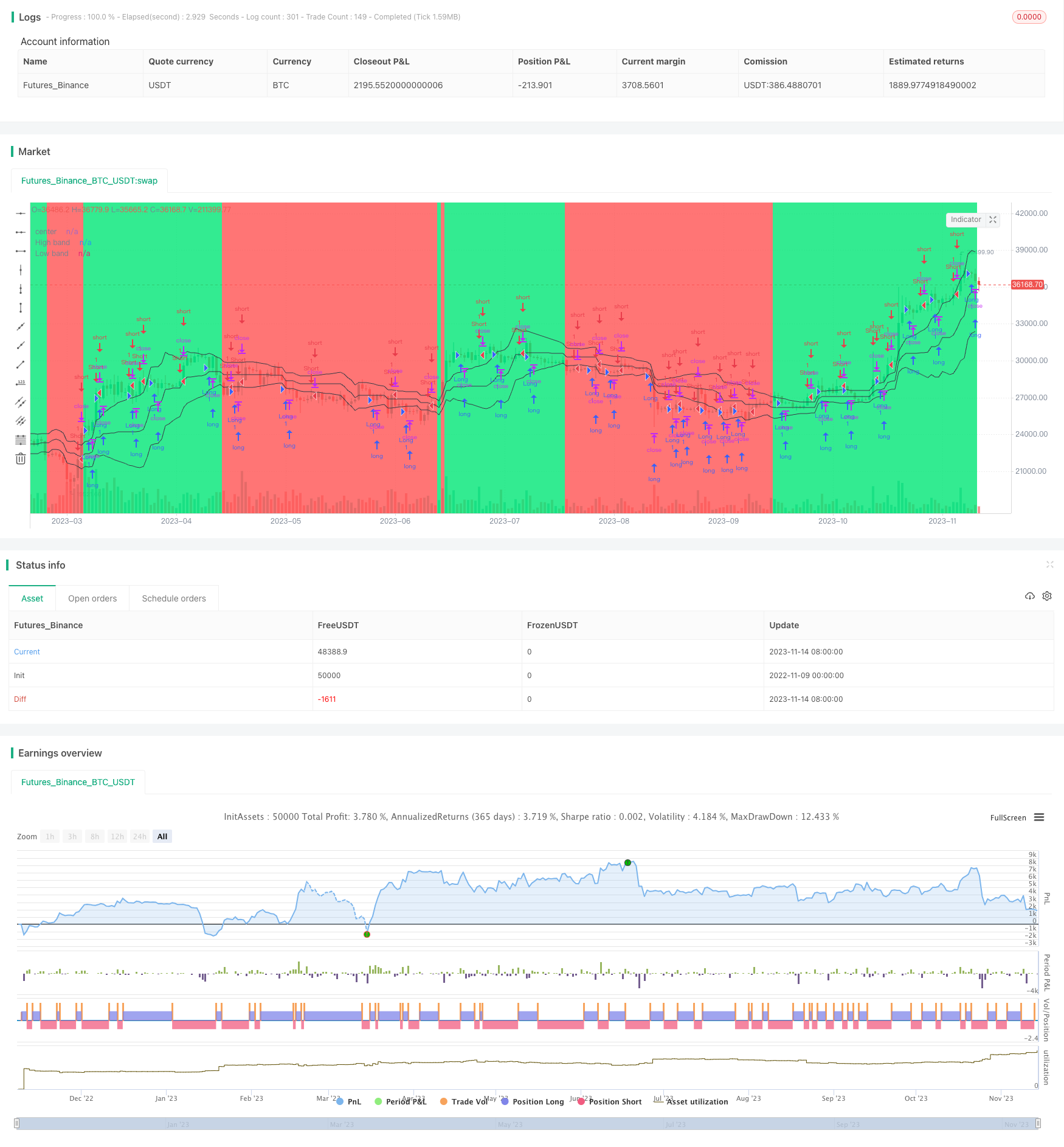
概述
本策略是一个基于布林带的趋势追踪策略。它使用布林带计算股价的上下区间,结合K线实体判断趋势方向,在趋势区间突破时进行 longing/shorting 操作。该策略适用于具有明显趋势的股票,能够抓住趋势的中长线盈利机会。
策略原理
本策略使用布林带的上带、中线、下带来判断价格区间。布林带上下两条带线包裹价格,中线为均线,带宽度随价格波动程度变化。当价格从下方上破布林带上线时,表明价格开始向上突破区间,rieve 为做多信号。当价格从上方下破布林带下线时,表明价格开始向下突破区间,则为做空信号。
布林带区间突破判断趋势方向后,策略还会结合K线实体方向进行确认。如果K线实体方向与趋势方向一致,如出现多头趋势中阳线,就进行开仓操作。如果K线实体方向与趋势方向相反,如出现多头趋势中阴线,则跳过该信号。这个设计的目的是进一步避免假突破带来的风险。
具体来说,策略的交易信号生成规则如下:
计算布林带上下两条带线及中线,判断价格所处区间
当价格从下向上突破布林带上线时,判断为多头信号
此时如果K线为阳线,确认趋势,则进行开多仓
当价格从上向下突破布林带下线时,判断为空头信号
此时如果K线为阴线,确认趋势,则进行开空仓
以给定的百分比止盈或止损
通过布林带区间突破入场,并结合K线实体方向进行二次确认,可以有效识别趋势方向,在趋势初期获得较好ENTRY,于趋势中期获得盈利离场。
优势分析
这是一个较为典型的趋势追踪策略,具有以下几点优势:
使用布林带具有自适应性,可以动态调整突破区间,适用于不同波动率的股票
结合K线实体进行二次确认,可以过滤假突破 bringing
采用中长线持仓,降低交易频率,有利于减少交易成本和滑点损失
追踪趋势中期,避开短期震荡,可以获得较好的风险收益比
程序量化执行,回测结果优秀,实盘表现具有稳定性
策略 concept 清晰,容易理解,具有扩展空间
通过布林带判断趋势方向,K线确认入场时机,可以有效抓住中长线数量优势所带来的盈利机会。这是一个具有较强实战性的策略。
风险分析
本策略也存在一些风险需要注意:
突破失败风险。布林带突破其实质是概率事件,存在一定可能的假突破。
反转风险。中长线趋势也可能出现反转,需要设定合理的止损点以控制风险。
参数优化风险。布林带参数和止损点需要根据不同股票合理优化,否则会影响策略稳定性。
过度优化风险。针对历史数据过度优化参数,会导致策略 curve fitting。
实盘执行风险。程序回测与实盘执行也会存在一定的偏差。
针对以上风险,可以通过以下方法进行改善:
优化布林带参数,选取合适的带宽度。
结合更多因素确认趋势,如交易量等。
动态调整止损点,防止过大反转造成损失。
采用 walk forward analysis 等方法避免过拟合。
优化下单方式,控制实盘执行效率。
优化方向
本策略还可从以下几个方面进行继续优化:
结合更多指标确认趋势,如KDJ,MACD等,提高信号准确率。
采用机器学习方法动态优化布林带参数,而不是固定参数。
在突破点附近设置买卖区间,生成更精确的交易信号。
优化止盈止损策略,采用动态跟踪止损或部分止盈方式。
引入资金管理优化,动态调整仓位,控制单笔风险。
结合高级执行方式,改善实盘效果,降低交易成本和滑点。
增加对市场环境的判断,在特定环境下关闭策略,控制风险。
通过引入更多技术指标和优化手段,可以进一步增强策略的稳定性和盈利能力,获得更出色的回测和实盘效果。
总结
本策略是一个典型的趋势追踪策略,核心思路是以布林带作为动态区间,判断价格趋势方向。结合K线实体进行二次确认,在趋势初期布林带突破点入场,目标为趋势中期的量级优势。
该策略具有使用布林带判断趋势、K线确认信号、降低交易频率、程序化执行等优势。也存在一定的假突破风险、止损优化难度、实盘效果偏差等问题。通过引入更多技术指标、动态优化参数以及高级执行手段等,可以进一步增强策略稳定性和实盘表现。
总体来说,本策略作为一个典型的趋势追踪策略,其核心思路清晰、易于实现,具有较强的可行性。在持续优化和严格风险控制下,可以成为量化交易体系中的一个有效策略模块。
/*backtest
start: 2022-11-09 00:00:00
end: 2023-11-15 00:00:00
period: 1d
basePeriod: 1h
exchanges: [{"eid":"Futures_Binance","currency":"BTC_USDT"}]
*/
//@version=2
strategy("Noro's Bands Scalper Strategy v1.2", shorttitle = "Scalper str 1.2", overlay=true, default_qty_type = strategy.percent_of_equity, default_qty_value=100.0, pyramiding=0)
//Settings
needlong = input(true, defval = true, title = "Long")
needshort = input(true, defval = true, title = "Short")
takepercent = input(0, defval = 0, minval = 0, maxval = 1000, title = "take, %")
needct = input(false, defval = false, title = "Counter-trend entry")
len = input(20, defval = 20, minval = 2, maxval = 200, title = "Period")
needbb = input(true, defval = true, title = "Show Bands")
needbg = input(true, defval = true, title = "Show Background")
src = close
//PriceChannel 1
lasthigh = highest(src, len)
lastlow = lowest(src, len)
center = (lasthigh + lastlow) / 2
//Distance
dist = abs(src - center)
distsma = sma(dist, len)
hd = center + distsma
ld = center - distsma
hd1 = center + distsma / 2
ld1 = center - distsma / 2
//Trend
trend = close < ld and high < center ? -1 : close > hd and low > center ? 1 : trend[1]
//Lines
colo = needbb == false ? na : black
plot(hd, color = colo, linewidth = 1, transp = 0, title = "High band")
plot(center, color = colo, linewidth = 1, transp = 0, title = "center")
plot(ld, color = colo, linewidth = 1, transp = 0, title = "Low band")
//Background
col = needbg == false ? na : trend == 1 ? lime : red
bgcolor(col, transp = 80)
//Body
body = abs(close - open)
smabody = sma(body, 100)
//Signals
bar = close > open ? 1 : close < open ? -1 : 0
up7 = trend == 1 and ((bar == -1 and bar[1] == -1) or (body > smabody and close < open)) ? 1 : 0
dn7 = trend == 1 and bar == 1 and bar[1] == 1 and close > strategy.position_avg_price * (100 + takepercent) / 100 ? 1 : 0
up8 = trend == -1 and bar == -1 and bar[1] == -1 and close < strategy.position_avg_price * (100 - takepercent) / 100 ? 1 : 0
dn8 = trend == -1 and ((bar == 1 and bar[1] == 1) or (body > smabody and close > open)) ? 1 : 0
if up7 == 1 or up8 == 1
strategy.entry("Long", strategy.long, needlong == false ? 0 : trend == -1 and needct == false ? 0 : na)
if dn7 == 1 or dn8 == 1
strategy.entry("Short", strategy.short, needshort == false ? 0 : trend == 1 and needct == false ? 0 : na)